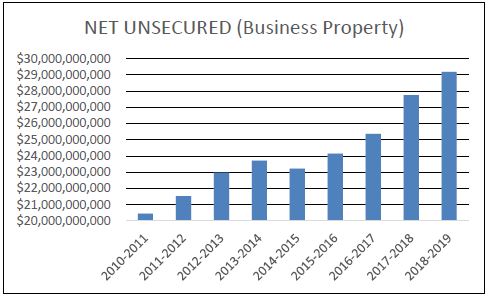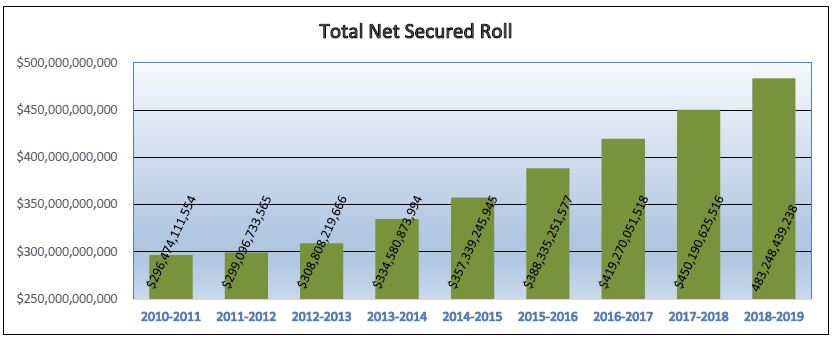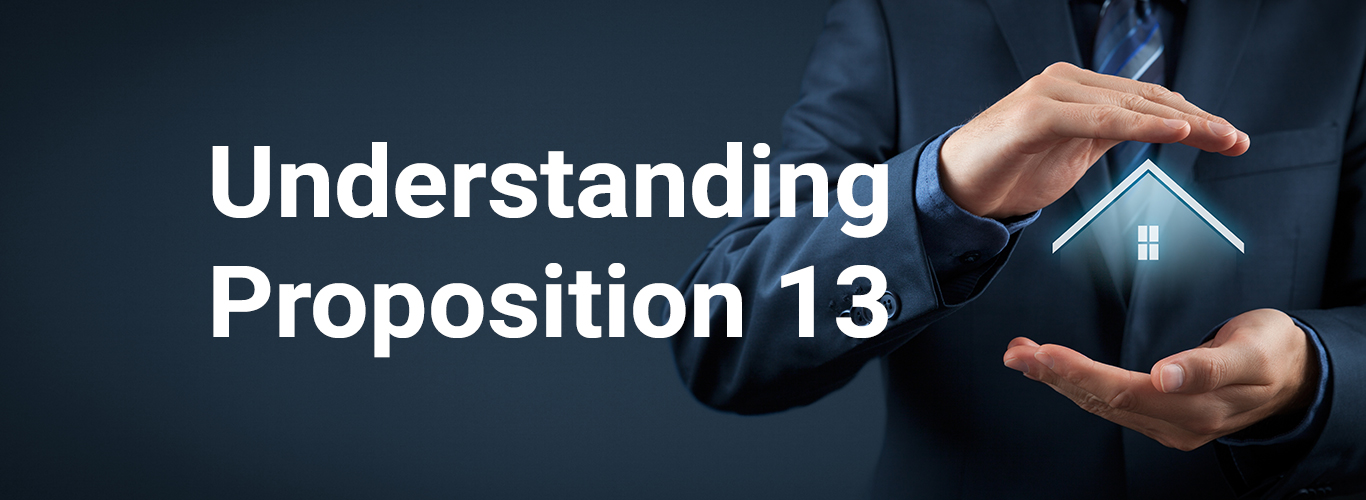“Up and to the right, not forever,” cautions Assessor Larry Stone.
Consistent with the second longest post-recession recovery, led nationally by the Bay Area’s high technology sector, County Assessor Larry Stone announced today that the annual assessment roll hit $483.2 billion, a 7.34 percent increase over the prior year. The assessment roll reflects the total net assessed value of all real and business property in Santa Clara County as of January 1, 2018.
During the “dot-com” boom 18 years ago, commercial real estate development was largely speculative, often leasing to high tech startups with little or no earnings. When the market went from “dot-com” boom to “dot-com” bust, office vacancy increased to 25 percent in 2009, the height of the “Great Recession.”
Today, major well-established companies like Google, Apple, Samsung, LinkedIn, and Nvidia with real earnings and profits, are acquiring land and buildings, favoring ownership over traditional long-term leases, adding significant stability to the office market against future recessions.
The growth in the assessment roll this year is due primarily to significant new construction, changes in ownership, and growth in business property, i.e. machinery, equipment, computers, and fixtures. In addition, the two percent increase in the assessed value of all properties mandated by Proposition 13, also contributed to the increase in the assessment roll.
One single property owner, Apple Computer, accounted for an increase of $1.5 billion in assessed value, primarily from construction of the Apple Park (Spaceship) campus, in addition to Apple’s acquisition of several existing office buildings and the acquisition of business property.
“Rebounding from the greatest economic downturn since the Great Depression, Silicon Valley economy has surged back to record levels. Santa Clara County is well into the eighth year of recovery since the bottom of the recession in 2010. The turnaround is truly remarkable,” said Stone.
In 2010, unemployment in Santa Clara County stood at 11.2 percent. In May 2018, local unemployment dropped to 2.3 percent, a modern record. Extremely low unemployment rates in Silicon Valley have driven the cost of tech talent to an all-time high, creating a serious high-tech labor shortage. There are more job openings than the number of people unemployed.
“Employment growth during the past eight years has triggered an incredible demand for office and industrial space, apartments, and homes. The result has been a nearly two-thirds increase in the County’s net assessed values,” commented Stone.
However, Stone warned, “Silicon Valley and California are not immune to economic cycles, and our cycles tend to go up and down faster and steeper than the state or the nation. Economic adjustments are inevitable. Real estate owners and developers are beginning to report indications of a mild economic slowdown. Hopefully it will be a soft landing.”
Emerging economic indicators reflect a softness in office and apartment rents and vacancies, primarily due to the aggressive development, some would say overdevelopment, of both new office space and apartment units. Office vacancy declined from 25 percent in 2009 to 11 percent at the end of 2017. But in the first quarter of 2018, office vacancy jumped to 17.4 percent. The preleasing of office space under construction has fallen from a high of 80 percent in 2016, to 48 percent last year, an indication of an oversupply of new office space.
“Uncertainties created by confusing national economic and trade policies, dysfunction and gridlock in Washington, D.C., rising interest rates, are leading to large federal budget deficits, contributing factors to the cooling of the economy,” said Stone.
“The six-year apartment market ‘boom’ is also beginning to soften as price fatigue sets in. Rent growth in 2017 dropped dramatically to less than 3 percent. The peak of the apartment market appears to have passed. Apartment rents in the metropolitan San Jose area increased a whopping 52 percent since 2010, a level that is unsustainable for a healthy local economy.”
“I anticipate local economic cycles will be reflected in future assessment rolls. Housing will likely contribute to the change due to overvalued home prices, driven by too much money, including foreign investments, chasing too few homes, causing prices to skyrocket,” said Stone. Last year, 68 percent of homes in Santa Clara County sold for more than the asking price, and 22 percent of residential transactions were all cash. “Because of the rapid increase in home sales at record prices, residential properties most vulnerable to a downturn are those purchased during the past three years,” cautioned Stone.
The collapse of residential property values during the “Great Recession” (2009-2011) caused the Assessor to proactively reduce the assessed value of 136,559 properties for a total assessment reduction of $27 billion.
The other major contributor to the net assessment roll is business property, which grew 5.15 percent. The decrease of corporate expenditures for machinery, computer equipment, furniture, and fixtures is another indication that our local economy is stabilizing.

The Assessor’s Office has once again closed the assessment roll by the statutory deadline of July 1, 2018, returning $650,000 unspent funds to the County’s general fund.
Every five years the State Board of Equalization (BOE) conducts a comprehensive audit to verify the accuracy of the County’s assessments and to measure compliance with California’s Revenue and Taxation codes, including Proposition 13. The minimum value compliance ratio is 95 percent. The BOE audit of Santa Clara County indicated a net ratio of 99.48 percent. “Getting it right is the most important thing when it comes to treating taxpayers fairly,” said Board of Supervisors President Joe Simitian. “It’s reassuring to know that our Assessor, Larry Stone, and his office have really gone the extra mile to deliver accurate results.”
The Assessor’s Office will be mailing the annual assessment notice to 490,146 property owners reporting each property’s 2018-2019 assessed value on Friday, June 29. The notice serves as the basis for the property tax bill mailed in the fall. Santa Clara County is one of only nine other counties in California providing early notice to all property owners. “Most property owners in California learn of their assessed value for the first time when they receive their property tax bill in October,” said Stone.
What property owners can do if they disagree with the assessed values on their notice card?
Property owners who disagree with the assessed value printed on their notice are encouraged to take advantage of the Assessor’s “online tool,” available 24/7, enabling property owners to review the sale of comparable properties the Assessor used to determine their assessment. An interactive service modeled after online banking, the Opt-In Tool, allows taxpayers to securely receive assessment notices, in addition to interacting with the Assessor’s Office electronically rather than by mail, telephone, or in person. To access the data, a property owner must have a user name and password created last year, or the PIN listed in the annual assessment notice.
Property owners who can demonstrate that their assessed value is higher than the market value of their property are encouraged to request an informal review of their assessment. The Assessor’s property appraisal staff will complete as many informal reviews as possible prior to August 1, the deadline for making changes that will be reflected on the property tax bill mailed in the fall. More information is available at www.sccassessor.org.
The annual notice also describes the process for filing a formal assessment appeal by the September 15, 2018 deadline. Residential property owners who decide to file a formal assessment appeal, are encouraged to request their appeal be adjudicated by an independent residential Value Hearing Officer (VHO), rather than the more formal three-member Assessment Appeals Board. VHO hearings are scheduled frequently, allowing a more rapid resolution.
“Property owners who disagree with the assessed value should not wait for the tax bill before filing an appeal, as the tax bill is mailed by the Tax Collector after the assessment appeal filing deadline,” said Stone.
More information is available from the Clerk of the Board by calling (408) 299-5088, or going to their website (http://www.sccgov.org/assessmentappeals).
The major beneficiaries of property tax revenue are California’s public schools and community colleges. 51 percent of local property tax revenue generated in Santa Clara County goes to fund public education.
Note: Additional information, such as a detailed city-by-city breakdown of the assessment roll, is available in the Assessor’s Annual Report published in August. Property owners who want to receive the Annual Report can send an email to This email address is being protected from spambots. You need JavaScript enabled to view it..




